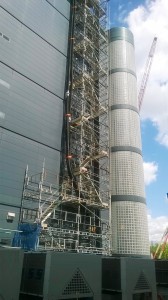Since opening in 1990 this Docklands Data Centre is Europe’s first purpose-built, neutral data centre and has grown to become one of the largest, global data centre providers facilitating the majority of the London Internet Exchange’s (LINX’s) capacity. This data centre is the only company in the UK that operates an on-site private dual primary
Since opening in 1990 this Docklands Data Centre is Europe’s first purpose-built, neutral data centre and has grown to become one of the largest, global data centre providers facilitating the majority of the London Internet Exchange’s (LINX’s) capacity.
This data centre is the only company in the UK that operates an on-site private dual primary substation encompassing a total capacity of 50MVA with chilling and two 132kV power lines directly connected to the National Grid reducing transmission losses.
As part of their on-going planned maintenance at this data centre the upgrade of their dry air rood chillers were programmed for renewal before the summer period of 2015 commenced. The regular maintenance & upgrade of the data halls chiller system is critical to it’s operation as thetemperature within the data halls must remain between specific parameters. Therefore, the Facilities Manager made the decision to source a temporary chiller solution at the beginning of 2015 to ensure targets were met. This would then enable the Data Centre Facilities Management team to take the existing dry chillers offline, remove them so they can be upgraded with new specification chillers.
Having worked together on numerous occasions, a dependable and cohesive working relationship between Powerhire and the Data Centre had already been established and it was therefore an easy decision for the Facilities Manager to call upon Powerhire to propose a bespoke temporary chiller system solution whilst the required upgrade was carried out.
Powerhire’s Technical Sales Manager visited site to liaise with the Facilities Manager and discussed in depth how the temporary chiller system could work, especially with the limitations on space. With all the necessary information to hand following the site visit, our Technical Sales Manager recommended a variety of options to suit varying budgets for the supply of temporary chillers, the infrastructure for additional power distribution and a programme for installation and commissioning.
Once the final solution was chosen by the client Powerhire assigned a dedicated Project Manager to oversee the itinerary for all proceedings as well as putting together the necessary Risk Assessments, Method Statements, H&S Documentation and full CAD drawing for the finalised temporary chiller system.
As with any Project, prior to installation, all equipment was fully tested and serviced before loading onto our transportation for delivery. Once all equipment was onsite, Powerhire’s Engineers liaised closely with the onsite FM as the 6 temporary chillers were being supplied by 3 different substations within the building’s live power infrastructure.
 The installation was a complex one due to the space restrictions and installation was undertaken methodically, section by section with cable runs kept to a minimum. The proximity of each substation was quite a distance from each other as were the 6 temporary chillers. Two large Mains Distribution Units (MDU’s) were installed inside a loading bay, closest to the temporary chillers and substations 1 and 2. Due to the height restrictions at the entrance to the loading bay the MDU’s required purpose built protective framework to fit underneath whilst skating into the correct position. Temporary chillers 1, 2, 3 & 4 were connected up to the 2 MDU’s in the loading bay and completely separate from the temporary chiller system setup at substation 3, as a precautionary measure to act as a back-up solution. Two smaller MDU’s were set up at ground level at the end of a walkway and supplied by substation 3 with connection to the 2 remaining temporary chillers.
The installation was a complex one due to the space restrictions and installation was undertaken methodically, section by section with cable runs kept to a minimum. The proximity of each substation was quite a distance from each other as were the 6 temporary chillers. Two large Mains Distribution Units (MDU’s) were installed inside a loading bay, closest to the temporary chillers and substations 1 and 2. Due to the height restrictions at the entrance to the loading bay the MDU’s required purpose built protective framework to fit underneath whilst skating into the correct position. Temporary chillers 1, 2, 3 & 4 were connected up to the 2 MDU’s in the loading bay and completely separate from the temporary chiller system setup at substation 3, as a precautionary measure to act as a back-up solution. Two smaller MDU’s were set up at ground level at the end of a walkway and supplied by substation 3 with connection to the 2 remaining temporary chillers.
The only available air circuit breakers [ACBs] available from the substations to Powerhire were rated at 6300Amps and therefore the utilisation of the Mains Distribution Units inline was essential to reduce the supply current from the substations to the temporary chillers, rated at 290Amps. Using the MDU’s within the temporary chiller system installation also enabled Powerhire to keep the amount of temporary cabling required to a minimum which in turn reduced the amount of scaffold needed for the higher level cable runs and cable ladder racks for the low level cable runs.
The cabling was installed with immense care both at higher level and in particular at ground level. The ground level temporary cable was laid trefoil within a double stack ladder rack underneath a walkway. This neat and logical cable set up was practically invisible to passing footfall and the moving traffic adjacent to the walkway, posing no hazard & disruption to the public. Scaffolding was required for ground level to high level cable runs, again installed trefoil within a double stack ladder rack to achieve not only a neat, unobtrusive finish but minimal restrictions to the loading bay and surrounding secure compounds.
A total of 4KM of temporary cabling was installed to connect the substations, MDU’s and chillers within their designated location. And both the wiring and installation of the ladder rack were carried out on a live data centre immediately next to a busy internal road within the data centre premises meaning extreme care and planning was taken into account throughout the entire temporary chiller project installation for both footfall and vehicular traffic.
Once the temporary chillers, mains distribution units & cabling were fully installed the entire systems was commissioned by Powerhire and signed off by the client for use.
